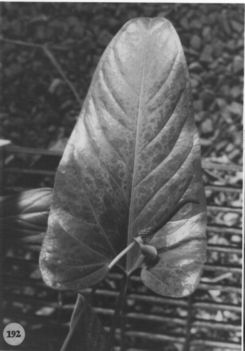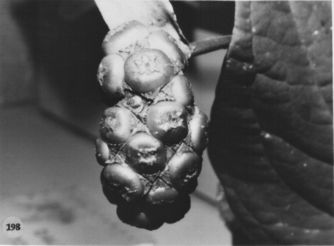





Anthurium subovatum Matuda,
Bol. Soc. Bot. Mexico 24: 36. 1959. TYPE: Mexico. Oaxaca: road between Cerro Pelon and Yetia, elev. 1,900 m, January 12, 1959, Mac-Dougall 406 (MEXU, holotype).
Terrestrial or epiphytic; stem to 2.5 cm diam.; leaf scars ca. 2.3 cm wide; roots tan, numerous, 3-8 mm diam.; cataphylls moderately thick, 5-8.5 cm long, acute at apex, subapical apiculum 1.9-2.7 cm long, drying brown, persistent, splitting at base, remaining intact at apex.
LEAVES with petioles erect-spreading, 20-51 cm long, 5-7 mm diam., shallowly and broadly sulcate, the margins sharp, rounded abaxially; geniculum 1-2 cm long, usually tinged red-violet; blade narrowly ovate-triangular to ovate, moderately thick, acute and apiculate at apex (acumen 2-5 mm long), weakly to prominently lobed at base, 27-44 cm long, 10-26 cm wide, broadest at base or just above point of petiole attachment; anterior lobe 26-41 cm long, the margins ± straight to convex; posterior lobe 4.5-13 cm long, usually directed upward from point of petiole attachment; sinus arcuate with petiole decurrent to arcuate to parabolic (when flattened), round to truncate at apex; upper surface semiglossy, lower surface matte, both surfaces sometimes glaucous; midrib weakly, convexly raised above, broad al base, narrowing and sunken at apex, convexly raised almost to apex below; basal veins 3-5 pairs, the first free, second to fifth coalesced 1-3 cm; posterior rib naked; primary lateral veins 3-7 per side, departing midrib at 30°-50° angle, loop-connecting to collective vein, sunken above, raised below; secondary and tertiary veins clearly visible, weakly sunken above, raised below; midrib, basal, and primary lateral veins usually tinged red-violet on lower surface, sometimes faintly tinged on upper surface; collective vein usually arising from the first or second basal vein, sunken above, raised below, 4-7 mm from the margin.
INFLORESCENCE spreading to pendent, ca. as long as leaves; peduncle 28-49 cm long, 4-6 mm diam., sometimes weakly glaucous or tinged red-violet; spathe moderately thick, lanceolate, green sometimes suffused with red-violet, matte on both surfaces, 6-9.5 cm long, 1.5-2.7 cm wide, gradually acuminate al apex, rounded to obtuse at base, inserted at 40°-50° angle on peduncle; spadix green turning dark violet-purple, 10.3-19 cm long, 7-11 mm diam. at base, 3-4 mm diam. at apex; flowers rhombic to 4-lobed, 3.7-4.2 mm long, 3.2-3.9 mm wide, the sides weakly tojag-gedly sigmoid; 5-7 flowers visible in the principal spiral, 6-12 flowers visible in the alternate spiral; tepals matte, minutely punctate, with sparse droplets as stamens emerge, lateral tepals 1.5-2.6 mm wide, the inner margin broadly rounded, usually turned up against pistil; pistil green, tinged violet-purple, weakly emergent; stigma linear, ca. 0.8 mm long; lateral stamens emerging slowly from the base, one at a time, the alternates following by 1-3 spirals; faint yeasty odor as stamens emerge; anthers creamy white, held in tight circle, retracting slightly as pollen disperses; the-cae ovoid; pollen pale yellow to creamy white.
INFRUCTESCENCE spreading-pcndent; spathe green, persistent; berries bright orange, sometimes developing only in the basal one half, broadly obovate, rounded to truncate at apex, 6-9 mm long, 7-9 mm wide; mesocarp thick, juicy with numerous raphide cells; seeds 1 or 2, pale green, obovoid-ellipsoid, weakly flattened, 4.5-5.6 mm long, 3.5-5 mm wide, 2.8-3 mm thick, with sticky appendages at both ends. Figs. 192 and 198.
Anthurium subovatum is restricted to Mexico in the Sierra de Juare of northern Oaxaca at 1,500 to 2,100 m in cloud forests in what appears to be a premontane rain forest life zone. The species is a member of section Belolonchium and is characterized by its sharply sulcate petioles, thick subcordate to truncate leaf blades with sharply ascending reddish basal veins, numerous clearly visible tertiary veins, violet-purple spadix, and obovoid, more or less truncate, bright orange berries. It is similar to A. subcordatum in having a similar leaf shape, but the blades of A. subovatum are generally broadest at the base with the posterior lobes often directed
 |
 |
Mesoamerican Specimens Mexico
Oaxaca: 2000 m,, 15-IX-1993, Zamudio, S. 7 E. Pérez C. 9183
(MO).